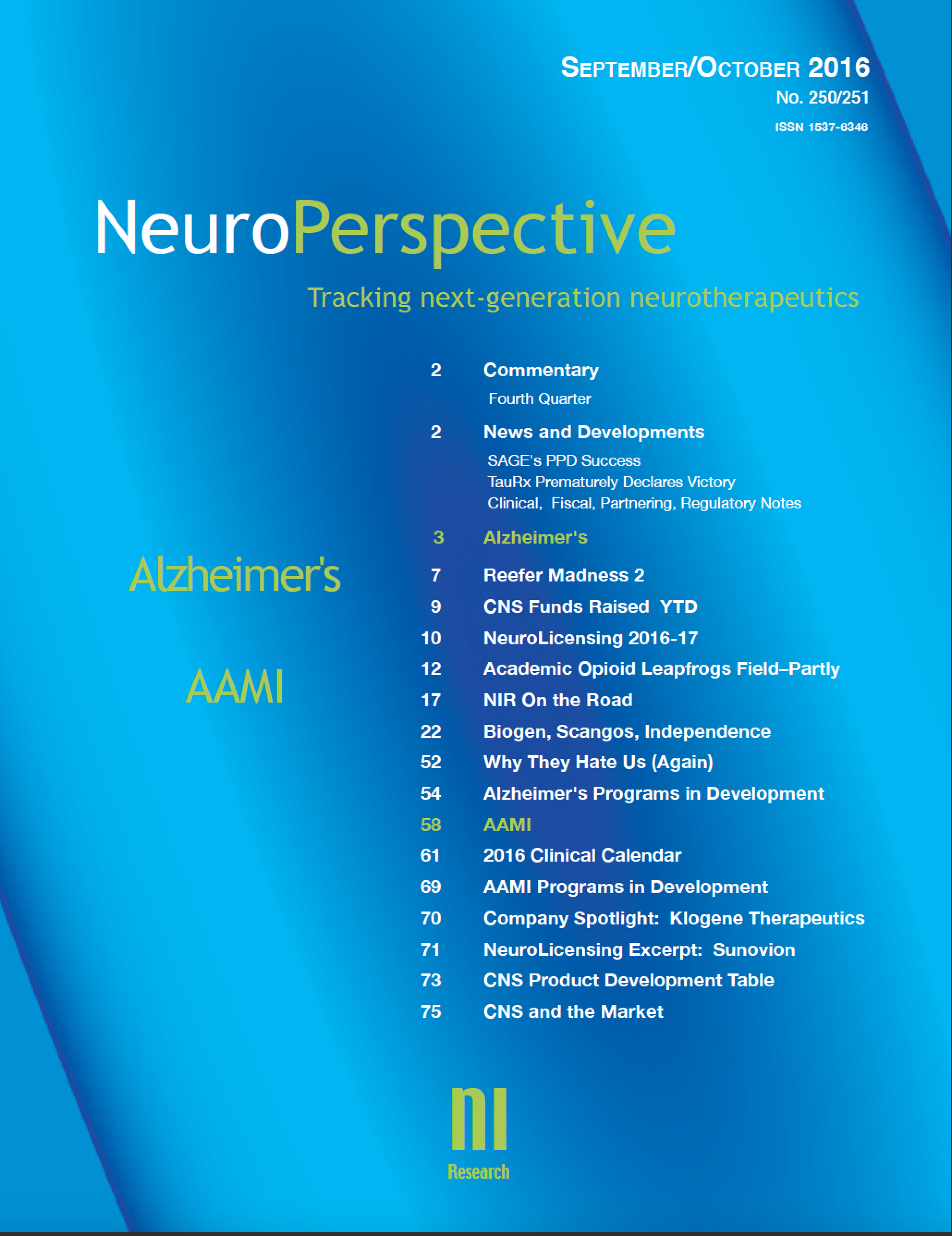NeuroPerspective has released its Fall 2025 issue, featuring our annual comprehensive review of Alzheimer’s, as well as reviews of Depression and Narcolepsy.
Our Alzheimer’s review appraises the impact of the commercial advents of Eisai/Biogen’s Leqembi/lecanemab and Lilly’s Kisunla/donanemab. They provide an imperceptible slowing of disease progression and a rare but not inconsequential risk of ARIA, that may prove to be deadly for .5-1% of patients, a seemingly small percentage that could translate into noticeable casualties given the size of the patient population. That risk could be reduced if genetic screening and exclusion of APOE4++ patients were mandated in the US, as is the case in the EU, but neither the companies nor regulators have taken that step, leaving the weighing of risk vs. benefit up to patients and their families. But the launch of two ostensible disease-modifiers has provided the medical/insurance system with the opportunity to develop treatment and payor infrastructure that will serve future, more effective options, and has reawakened the pharma industry to the commercial potential to be found here. Other amyloid mAbs, including Lilly’s remternetug, Roche’s trontinemab and programs from Acumen, AbbVie/Aliada, and ProMIS, hope to improve the risk/benefit profile, but they are years away from potential approval. The quest to improve BBB access has led to multiple partnerships for BBB-transit programs: During 2025 alone, Novartis has added two to its developmental repertoire via licensing/option deals with BioArctic and Sironax; GSK partnered with ABL Bio; Acumen licensed a JCR Pharma program; and Lilly licensed a Sangamo asset.
Hopes for tau as a target for monoclonal antibodies have been thus far dashed due to limited BBB access and even less, if any, intracellular access. There are active vaccine and antibody fragment programs that hope to improve on the original mAb legacy, including BMS/BioArctic, JNJ/AC Immune, and Nuravax. Beyond amyloid and tau, the most promising programs appear to be in the neuroinflammation and cellular waste disposal categories. We have been intrigued by TREM2 as a means of modulating microglial activity. But the unexpected demise of the Takeda/Denali lead mAb due to safety issues, in conjunction with evidence that TREM2 activation can itself lead to ARIA, complicates the picture. AbbVie/Alector’s AL002 failed, Novartis is in PhII. The small molecule TREM2 activator in development by Sanofi/Vigil may have an advantage in the TREM2 domain, at least until Muna Therapeutics advances its program. There are downstream mediators that may be alternative targets, including PLCG2 and SHIP1, and NLRP3 inflammasome inhibitors (Halia and Cerevance) . The wait for Novo Nordisk’s semaglutide PhIII trials should be approaching its end. The recent work on the link between AD and lithium depletion is considered.
Symptomatic approaches could play a more important clinical role than the crop of very limited disease modifiers. But there has been complete silence regarding AbbVie/Syndesi’s ABBV-552 PhII data, which likely means bad news. Bristol Myers Squibb is assessing a number of KarXT dosing combinations for AD-psychosis, and first data should come soon. But tolerability issues in elderly patients leave the door ajar for other muscarinic candidates, including those from Neurocrine/Nxera, Neumora, and Maplight. Syndeio has developed a considerable body of evidence for its premise that there is an optimal level, and frequency, of NMDA upregulation for procognitive impact, and that historically it has often been exceeded, with negative results. A PhII in AD is being planned. Lighthouse Pharmaceuticals has obtained NIH funding for a definitive trial of its p.gingivalis infection hypothesis. AgeneBio continues to look for a partner to complete development of AGB101 as a treatment for non-APOE4 patients.
Among the 200+ programs assessed are those from: AbbVie/Aliada, Acumen, AC Immune, Actinogen, AgeneBio, Alnylam, Allyx, Alzamend, Anavex, BioArctic, Biogen, BMS, Eisai, GSK/Alector, JNJ, Klothea, Kynexis, Leal, Lexeo, Lighthouse, Lilly, Merck, Monument Biosciences, Muna, Myrobalan, Neumora, Nuravax, ProMIS, Prothena, Roche, Sironax, Syndeio, Takeda, TrimTECH, and Sanofi/Vigil.
There is also a slew of small companies whose programmatic execution has been as sloppy as their hyperbole, with Cassava, Anavex, Alzheon, Annovis prominent in that group.
The second major review is of Depression, an area being transformed as Psychiatry adds new therapeutic tools, and begins to meaningfully parse patient populations based on phenotypic or biomarker differentiators. New mechanisms are in clinical stage, including novel approaches from Xenon, HMNC, Syndeio, Alto Neuro, Actinogen, Autobahn, Engrail, Evecxia, and many others. There have been disappointments, such as the kappa opioid antagonists from JNJ and Neumora. With the growing positive data for Psychedelic options (e.g. Compass, Atai/ Beckley, Cybin, MindMed, Reunion, GH Research), and AbbVie’s partnership with Gilgamesh on GM-2505, the psychoplastogen wing (e.g. Delix, Onsero) has lost some momentum.
The third therapeutic area reviewed is Narcolepsy, the first time NP has reviewed that area since 2006. The timing is auspicious, as the highly successful oxybate franchises (Jazz, Avadel), which have shared the spotlight with H3 antagonist drugs (Harmony, Suven), now must contend with the prospect of orexinergic drugs that for the first time address the core deficit of narcolepsy. Major OX2-agonist programs come from Takeda, Alkermes, Centessa, Jazz, and Harmony Biosciences.
The Fall issue includes an overview of Saniona, the inheritor of NeuroSearch’s ion channel expertise, which has signed epilepsy drug partnerships with Acadia and Jazz Pharmaceuticals. The Psychedelics Update section appraises Reunion’s successful PhII in Post-Partum Depression and the recently disclosed CRL previously issued by the FDA to Lykos (now rebranded as Resilient Therapeutics) regarding the use of MDMA in PTSD. There is nothing there that would not be solvable by a comprehensive REMS program, and with the FDA’s current receptivity to Psychedelics, that possibility could re-emerge.
As always, there is coverage of significant clinical, fiscal, and partnering events. 125 pages.
NeuroPerspective is the quarterly review of the neurotherapeutics area offering essential, unique, and comprehensive coverage of developments in the science and the business of the CNS sector. A one-year (1-5 user) subscription is $3400. A 6-10 user subscription is $5600. Other customized user base and startup pricing options are available. The Fall issue is available as a single issue purchase, US$900.
Read More
